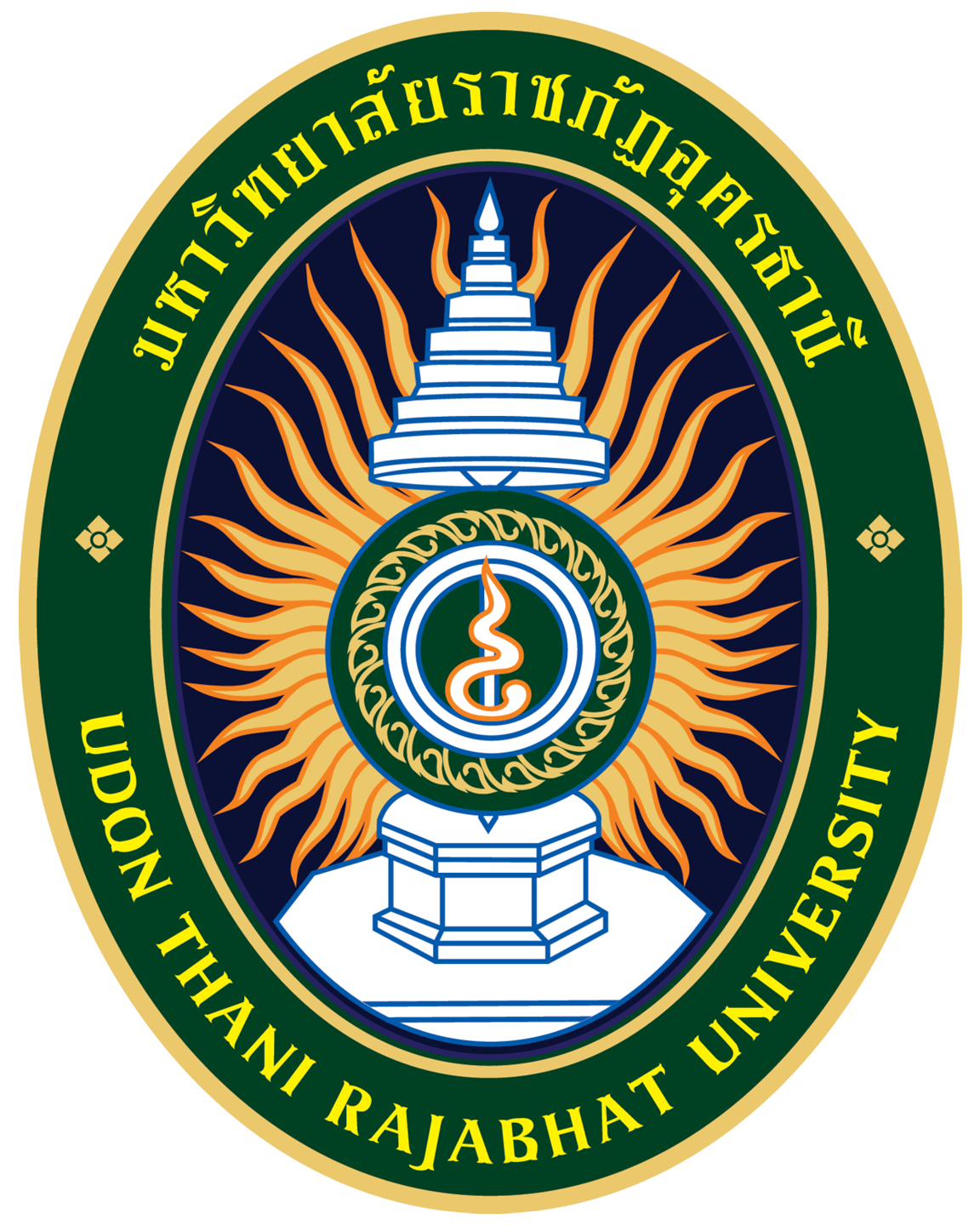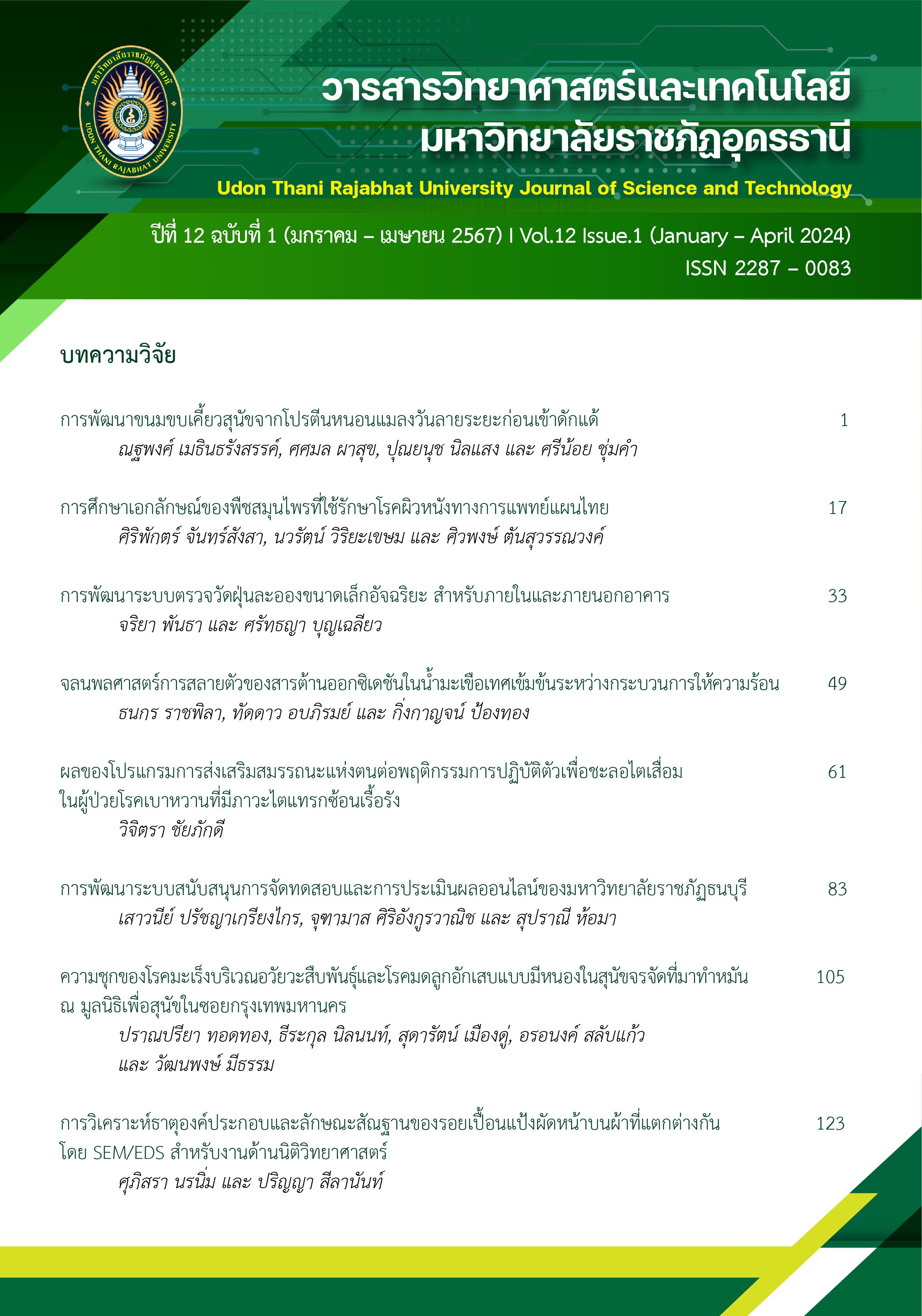จลนพลศาสตร์การสลายตัวของสารต้านออกซิเดชันในน้ำมะเขือเทศเข้มข้นระหว่างกระบวนการให้ความร้อน
Main Article Content
บทคัดย่อ
มะเขือเทศเป็นพืชเศรษฐกิจที่มีความสำคัญของจังหวัดสกลนคร มีการแปรรูปมะเขือเทศสดเป็นน้ำมะเขือเทศเข้มข้นมากกว่า 60,000 ตัน/ปี งานวิจัยนี้มีวัตถุประสงค์เพื่อศึกษาจลนพลศาสตร์การสลายตัวของสารต้านออกซิเดชันในน้ำมะเขือเทศเข้มข้นระหว่างการให้ความร้อน พบว่าเมื่อให้ความร้อนน้ำมะเขือเทศเข้มข้นที่อุณหภูมิ 75, 85 และ 95 °C เป็นเวลา 30 นาที มีร้อยละการต้านออกซิเดชันโดยทำปฏิกิริยากับ DPPH (2, 2-diphenyl-1-picryl-hydrazyl-hydrate) เท่ากับร้อยละ 30.19±1.38, 26.77±1.88 และ 23.26±1.12 ตามลำดับ เมื่อนำมาวิเคราะห์รูปแบบสมการเชิงเส้นเพื่อหาแบบจำลองของจลนพลศาสตร์ ค่าคงที่ของปฏิกิริยาการสลายตัว (k) จะลดลงจาก 0.0454 เป็น 0.0397 และ 0.0338 ตามลำดับ การสลายตัวของสารต้านออกซิเดชันในน้ำมะเขือเทศเข้มข้นเป็นไปตามความ สัมพันธ์ของปฏิกิริยาอันดับหนึ่ง (first order reaction) มีค่าพลังงานกระตุ้นได้เท่ากับ 15.70 กิโลจูลต่อโมล อุณหภูมิที่สูงขึ้นจะส่งผลให้สารต้านออกซิเดชันเกิดการสลายตัวมากขึ้นเช่นเดียวกันมีการสลายตัวมากขึ้นและที่อุณหภูมิเดียวกันเมื่อให้ความร้อนเป็นระยะเวลานานจะส่งผลให้สารต้านออกซิเดชันเกิดการสลายตัวมากขึ้นเช่นเดียวกันมีการสลายตัวมากขึ้นเช่นเดียวกัน
Article Details
เอกสารอ้างอิง
ธนกร ราชพิลา, ทวีศักดิ์ เลาหวิโรจน์, กิ่งกาญจน์ ป้องทอง, ศิรประภา ราชพิลา, ณัฐพงษ์ วงษ์มา, สิรินทัศน์ เลี่ยมแหลม, นรินทิพย์ ธิวะโต และ ปวีณา บุตรพรม. (2562). การวิเคราะห์สมรรถนะโซ่อุปทาน ประสิทธิภาพการผลิต และการพัฒนามาตรฐานวัตถุดิบ: มะเขือเทศอุตสาหกรรม. รายงานฉบับสมบูรณ์. มหาวิทยาลัยราชภัฏสกลนคร.
ประวิทย์ สันติวัฒนา และ จิตตินันท์ ปานประไพ (2559). การเปรียบเทียบความสามารถในการต้านอนุมูลอิสระของน้ำมันรําข้าว น้ำมันถั่วเหลือง น้ำมันปาล์ม มะเขือเทศ และงาดํา. วารสารวิทยาศาสตร์ประยุกต์, 15(1), 1-13.
สำนักงานเศรษฐกิจการเกษตร. (2566). ข้อมูลการผลิตสินค้าเกษตร. สืบค้นเมื่อวันที่ 8 ตุลาคม 2566, จาก https://www.oae.go.th/view/1/ข้อมูลการผลิตสินค้าเกษตร/TH-TH.
สุนทร พรจำเริญ. (2555). จลนศาสตร์เคมี. เอกสารประกอบการเรียนรายวิชา ว 40123 เคมี 3. สาขาวิชาเคมี โรงเรียนมหิดลวิทยานุสรณ์.
Blois, M. S. (1958) Antioxidant Determinations by the Use of a Stable Free Radical. Nature, 181, 1199-1200.
Food and Agriculture Organization. (2023). Food and agriculture data. Retrieved October 15, 2023 from https://www.fao.org/faostat/en/#data/QCL.
Hou, W.C., Chen, Y.C., Chen, H.J., Liu, Y.H., Yang, L.L. and Lee, M.H. (2001). Antioxidant activities of a 33 KDa root storage protein of sweet potato (Ipomoea batatas (L.) Lam cv. Tainong 57). Journal of Agricultural and Food Chemistry, 49, 2978-2981. https://doi.org/10.1021/jf0100705.
Kim, A. N., Kim, H. J., Chun, J., Heo, H. J., Kerr, W. L., & Choi, S. G. (2018). Degradation kinetics of phenolic content and antioxidant activity of hardy kiwifruit (Actinidia arguta) puree at different storage temperatures. LWT-Food Science and Technology, 89, 535–541. https://doi.org/10.1016/ j.lwt.2017.11.036.
Omodamiro, O. D. & Amechi, U. (2013). The phytochemical content, antioxidant, antimicrobial and anti-inflammatory activities of Lycopersicon esculentum (tomato). Asian Journal of Plant Science and Research, 3(5), 70-81.
Pokorny J. & Schmidt S. (2010). 15-Effects of processing and storage on antioxidant efficacy in foods, Editor(s): Eric A. Decker, In Woodhead Publishing Series in Food Science, Technology and Nutrition, Oxidation in Foods and Beverages and Antioxidant Applications, Woodhead Publishing, 2010, Pages 368-393,
Riadh, I., Chafik, H., Marcello, S. L., Imen, T. & Giuseppe, D. (2011). Antioxidant activity and bioactive compound changes during fruit ripening of high lycopene tomato cultivars. Journal of food composition and analysis, 24(4), 588–595. https://doi.org/10.1016/j.jfca.2010.11.003.
Riahi, A., & Hdider, C. (2013). Bioactive compounds and antioxidant activity of organically grown tomato (Solanum lycopersicum L.) cultivars as affected by fertilization. Scientia Horticulturae, 151, 90-96. https://doi.org/10.1016/ j.scienta.2012.12.009.
Sharma S. K. & Maguer M. L. (1996). Kinetics of lycopene degradation in tomato pulp solids under different processing and storage conditions. Food Research International, 29(3–4), 309-315.
Stahl, W., & Sies, H. (1996). Lycopene: A Biologically Important Carotenoid for Humans. Archives of Biochemistry and Biophysics, 336, 1-9. https://doi.org /10.1006/abbi.1996.0525.
Turturica, M., Stanciuc, N., Bahrim, G., & Rapeanu, G. (2016). Effect of thermal treatment on phenolic compounds from plum (Prunus domestica) extracts–A kinetic study. Journal of Food Engineering, 171(6), 200–207. https://doi.org/10.1016/j.jfoodeng.2015.10.024.
Wakil, W., Brust, G. E., & Perring, T. M. (2018). Sustainable management of arthropod pests of tomato. Amsterdam: Elsevier.


